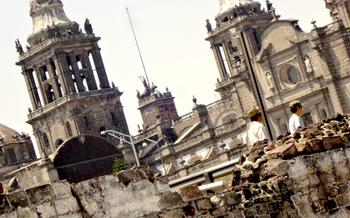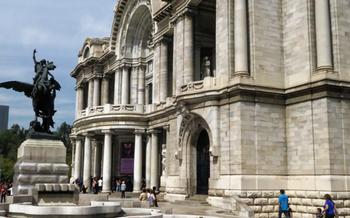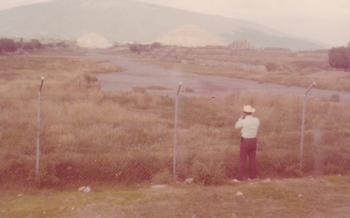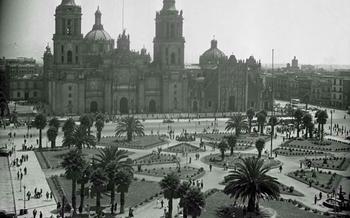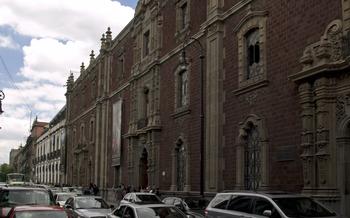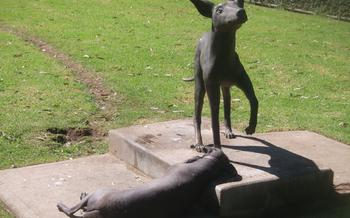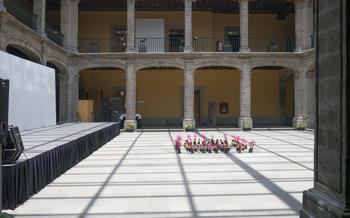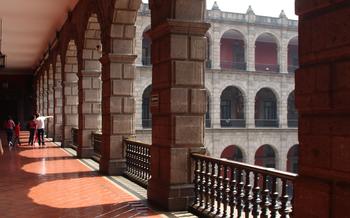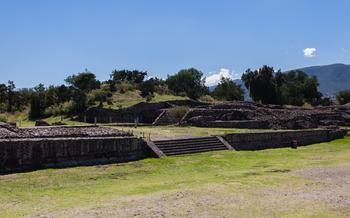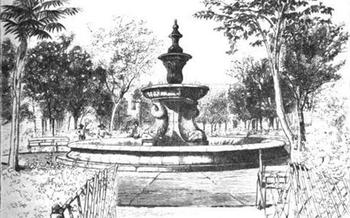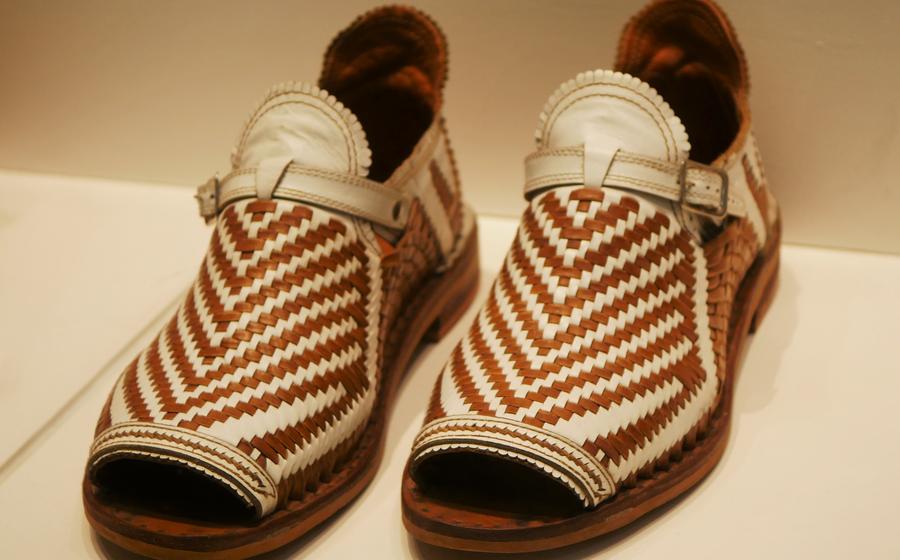
Museo de Arte Popular
- Museo de Arte Popular: A Treasure Trove of Mexican Folk Art
- Unveiling Mexican Identity Through Art
- A Journey Through Mexican History
- Interactive Exhibitions and Workshops
- Admire the Architectural Beauty
- Discover Unique Souvenirs
- Plan Your Visit
- Capture the Beauty
- Explore the Surrounding Area
- Learn About Mexican Craftsmanship
- Appreciate the Cultural Significance
- Support Local Artists
- Attend Special Events
- Be Open-Minded and Curious
- Insider Tip: Hidden Gems
Museo de Arte Popular: A Treasure Trove of Mexican Folk Art
The Museo de Arte Popular (MAP) is a vibrant and captivating museum dedicated to preserving and showcasing the rich tradition of Mexican folk art. Located in the heart of Mexico City's historic center, the MAP is a must-visit destination for anyone seeking to immerse themselves in the colorful and diverse world of Mexican craftsmanship.
Founded in 1982, the MAP is housed in a stunning colonial-era building that once belonged to the Counts of Santiago de Calimaya. The museum's collection boasts over 10,000 pieces of folk art from various regions of Mexico, representing the diverse cultural heritage of the country. From intricate alebrijes (fantastical animal sculptures) to hand-painted Talavera tiles, from colorful textiles to intricate silver jewelry, the MAP offers a comprehensive journey through the vibrant world of Mexican folk art.
Unveiling Mexican Identity Through Art
The Museo de Arte Popular houses a vast collection of Mexican folk art, providing visitors with a unique opportunity to discover the diverse range of artistic expressions that define Mexican culture. From intricate wood carvings and colorful textiles to whimsical alebrijes and delicate ceramics, each piece on display tells a story about the traditions, beliefs, and history of Mexico.
Explore the galleries dedicated to different regions of the country, and you'll find yourself transported to the bustling markets of Oaxaca, the serene landscapes of Chiapas, and the vibrant streets of Mexico City. Learn about the unique techniques and materials used by artisans from each region, and appreciate the intricate details and vibrant colors that bring each piece to life.
As you wander through the museum, you'll discover the stories and traditions behind each handcrafted object. Whether it's a whimsical alebrije inspired by ancient legends, a colorful textile woven on a traditional loom, or a hand-painted ceramic depicting scenes from everyday life, each piece holds a special meaning and connection to Mexican culture.
Immerse yourself in the vibrant world of Mexican folk art, and you'll come away with a deeper understanding of the country's rich history, diverse traditions, and the extraordinary creativity of its people.
A Journey Through Mexican History
The Museo de Arte Popular offers a captivating journey through the rich history of Mexican folk art, showcasing its evolution from pre-Columbian times to the present day. Witness the profound influence of indigenous cultures, whose intricate designs and vibrant colors laid the foundation for Mexican folk art. Explore how Spanish colonialism brought new techniques and materials, resulting in a unique blend of European and indigenous aesthetics. Furthermore, understand the impact of globalization on Mexican folk art, as it navigates the challenges of preserving tradition while adapting to contemporary influences.
The museum's collection tells the stories of the artists and artisans who created these masterpieces, shedding light on their lives, struggles, and triumphs. Through their works, you'll gain insights into the social, political, and economic forces that have shaped Mexican history and culture. Whether it's the intricate pottery of the pre-Columbian era, the colorful textiles of the colonial period, or the contemporary interpretations of traditional crafts, the Museo de Arte Popular offers a comprehensive exploration of Mexican folk art's historical significance.
Interactive Exhibitions and Workshops
Engage in hands-on activities and workshops to learn traditional Mexican art forms. Create your own alebrije (fantastical animal sculpture), paint a Talavera tile, or weave a colorful textile. Immerse yourself in the creative process and gain a deeper appreciation for Mexican craftsmanship. Take home a unique souvenir that you made yourself.
The Museo de Arte Popular offers a variety of interactive exhibitions and workshops that allow visitors to learn about and experience Mexican folk art firsthand. These hands-on activities are a great way to immerse yourself in the creative process and gain a deeper understanding of the techniques and traditions behind Mexican folk art.
One of the most popular workshops is the alebrije workshop, where you can create your own fantastical animal sculpture. Alebrijes are brightly colored, mythical creatures that are often made of wood or papier-mâché. The workshop will teach you the basics of alebrije making, from sculpting the form to painting the intricate designs.
Another popular workshop is the Talavera tile painting workshop. Talavera tiles are a type of ceramic tile that is made in the city of Puebla, Mexico. These tiles are known for their vibrant colors and intricate designs. The workshop will teach you the basics of Talavera tile painting, from preparing the tile to applying the paint.
If you are interested in textiles, you can also participate in a weaving workshop. The workshop will teach you the basics of weaving, from preparing the loom to weaving the fabric. You will be able to create your own unique textile, such as a scarf, a blanket, or a wall hanging.
The Museo de Arte Popular's interactive exhibitions and workshops are a great way to learn about and experience Mexican folk art firsthand. These hands-on activities are a fun and educational way to immerse yourself in Mexican culture.
Admire the Architectural Beauty
Marvel at the stunning colonial-era building that houses the Museo de Arte Popular. Built in the 17th century, the former monastery of San Pedro y San Pablo exudes an aura of history and elegance. Its intricate Baroque facade, adorned with carved stonework and vibrant tiles, hints at the treasures that lie within.
Inside, the museum's courtyards, galleries, and exhibition spaces blend traditional and contemporary architecture seamlessly. Wander through the airy courtyards, surrounded by lush greenery and colorful murals, and admire the interplay of light and shadow. The galleries, with their high ceilings and exposed beams, provide a fitting backdrop for the vibrant folk art on display.
Take a moment to appreciate the harmonious blend of old and new in the museum's architecture. The colonial-era features, such as the arched doorways and stone staircases, coexist with modern elements like glass panels and steel beams. This unique combination creates a dynamic and visually appealing space that enhances the visitor experience.
In the museum's tranquil surroundings, you can escape the hustle and bustle of Mexico City and immerse yourself in the beauty of Mexican folk art. Whether you're admiring the intricate details of a carved wooden mask or simply taking in the serene atmosphere, the Museo de Arte Popular offers a feast for the eyes and a respite for the soul.
Discover Unique Souvenirs
Within the walls of the Museo de Arte Popular, you'll find a treasure trove of authentic Mexican folk art pieces waiting to be discovered. The museum's gift shop is a haven for souvenir hunters, offering a wide array of one-of-a-kind items handmade by talented artisans from across the country. From intricately painted alebrijes (fantastical animal sculptures) to vibrant Talavera tiles and colorful textiles, each piece is a testament to the skill and creativity of Mexican artisans.
By purchasing souvenirs from the museum's gift shop, you're not only taking home a unique piece of Mexican culture but also supporting local communities. Your purchase directly benefits the artists and artisans who create these beautiful works of art, helping to preserve and promote traditional Mexican crafts.
So take your time browsing the gift shop, and don't be afraid to ask the friendly staff for recommendations. You're sure to find the perfect souvenir to commemorate your visit to the Museo de Arte Popular and bring a piece of Mexican culture home with you.
Plan Your Visit
To make the most of your visit to the Museo de Arte Popular, it is important to plan ahead. Check the museum's website for opening hours, admission fees, and guided tour schedules. The museum is typically open from Tuesday to Sunday, with extended hours on some days. Admission fees are reasonable, and there are discounts for students, seniors, and children. Guided tours are available in English and Spanish and offer a deeper insight into the museum's collection and history. Plan to spend at least two hours exploring the museum's extensive collection. The museum is located in the historic center of Mexico City, so you can easily combine your visit with a stroll through the city's other attractions, such as the Zócalo, the Palacio Nacional, and the Templo Mayor. The museum also offers a variety of educational programs and workshops, which provide a hands-on opportunity to learn about Mexican folk art. Be sure to take advantage of these programs if you have the time.
Capture the Beauty
The Museo de Arte Popular is a photographer's paradise, with vibrant colors and intricate details begging to be captured. Don't miss the opportunity to immortalize your visit with stunning photographs that will remind you of the beauty and diversity of Mexican folk art.
Remember to be respectful of the museum's photography policy and avoid using flash, as it can damage the delicate artworks. Also, ask permission before photographing any people featured in the exhibits, as they may not want their image shared publicly.
Once you have captured the beauty of the museum's collection, share your photos on social media to spread the word about this hidden gem. Use relevant hashtags such as #MuseoDeArtePopular, #MexicanFolkArt, and #MexicoCity to reach a wider audience and inspire others to visit.
By sharing your photos, you can help promote Mexican culture and support the talented artisans who create these beautiful works of art. Who knows, your photos might even inspire someone to visit the museum and experience the magic of Mexican folk art for themselves.
Explore the Surrounding Area
After immersing yourself in the world of Mexican folk art at the Museo de Arte Popular, take advantage of the opportunity to explore the vibrant surroundings of the historic center of Mexico City. Just a short walk away, you'll find the majestic Zócalo, the heart of the city, where you can admire the stunning Metropolitan Cathedral and the Palacio Nacional, home to breathtaking murals by Diego Rivera.
Stroll through the charming streets, lined with colorful colonial-era buildings, and soak up the lively atmosphere. Discover hidden plazas, quaint cafes, and bustling markets, where you can sample delicious Mexican cuisine and find unique souvenirs.
As night falls, the historic center transforms into a vibrant hub of activity. Enjoy a traditional Mexican dinner at one of the many restaurants, then catch a live music performance or dance show at a local venue. Experience the infectious energy of Mexico City's nightlife and immerse yourself in the city's rich cultural tapestry.
Learn About Mexican Craftsmanship
Engage with the museum's knowledgeable staff and docents to learn more about Mexican folk art. Their insights and expertise will help you understand the techniques, traditions, and symbolism behind each piece. Attend lectures, workshops, and demonstrations to deepen your knowledge of the creative process and the challenges faced by Mexican artisans. Read books, articles, and online resources to further explore the world of Mexican folk art and gain a comprehensive understanding of its history, significance, and global impact. Visit other museums and galleries dedicated to Mexican art and culture to broaden your perspective and appreciate the diversity of artistic expression in Mexico.
Appreciate the Cultural Significance
Folk art holds immense cultural significance in Mexican society. It is a vital thread that connects the past with the present, preserving and promoting Mexican traditions and identity. Each piece of folk art embodies the unique stories, beliefs, and customs of the region it comes from.
Through folk art, indigenous communities have expressed their cultural heritage and resisted assimilation. It has served as a powerful tool for social commentary and political resistance, reflecting the struggles and aspirations of the Mexican people.
By embracing folk art, Mexicans celebrate the diversity and richness of their culture. It is a source of pride and a way to connect with their roots. Folk art is not just a commodity; it is a living tradition that continues to evolve and inspire new generations of artists and artisans.
Recognizing the cultural significance of folk art is essential for understanding the soul of Mexico. It is an invitation to delve deeper into the country's history, traditions, and beliefs. By appreciating the skill, creativity, and passion of Mexican artisans, visitors can gain a profound respect and admiration for this vibrant and resilient culture.
Support Local Artists
Supporting local artists and artisans is crucial for preserving and promoting Mexican folk art. By purchasing directly from the creators, you contribute to the local economy and ensure that the benefits of tourism reach the people who deserve it most. Visit craft markets, cooperatives, and workshops to meet the talented individuals behind the beautiful pieces. Learn about their challenges and the importance of sustainable tourism. Spread the word about their work and encourage others to support Mexican folk art. Together, we can create a sustainable ecosystem that allows these artisans to continue creating their masterpieces while preserving the rich cultural heritage of Mexico.
Attend Special Events
To fully immerse yourself in the vibrant culture of Mexico, be sure to check the museum's calendar for special events, exhibitions, and festivals. Participate in traditional Mexican celebrations such as the Day of the Dead and the Guelaguetza. These events offer a unique opportunity to witness the incredible creativity and artistry of Mexican folk artists.
During the Day of the Dead, the museum hosts special exhibitions showcasing the iconic altars and offerings created to honor the deceased. The Guelaguetza festival, held in July, features colorful parades, traditional dances, and music from different regions of Mexico. These events are a feast for the senses and a wonderful way to experience the rich cultural heritage of Mexico.
Attending special events at the Museo de Arte Popular is not only a great way to learn more about Mexican culture, but also a chance to connect with the local community and create lasting memories.
Be Open-Minded and Curious
Approach the Museo de Arte Popular with an open mind and a willingness to learn. Embrace the diversity of Mexican folk art and appreciate its unique beauty. Ask questions, explore different perspectives, and challenge your own assumptions. Leave the museum with a newfound appreciation for Mexican culture and a desire to learn more.
The Museo de Arte Popular is not just a museum; it is a window into the soul of Mexico. It is a place to learn about the country's history, culture, and traditions through the eyes of its artists. By approaching the museum with an open mind and a curious spirit, you will gain a deeper understanding of Mexico and its people.
Insider Tip: Hidden Gems
Beyond the main galleries, the Museo de Arte Popular holds secret treasures waiting to be discovered. Venture into the tranquil courtyard and uncover a hidden garden, a serene oasis adorned with colorful plants and sculptures. Explore the lesser-known galleries on the upper floors, where you'll find hidden gems and unique pieces that may have escaped the attention of other visitors. Don't hesitate to engage with the museum staff, who are always happy to share their knowledge and recommend off-the-beaten-path places to visit. Take your time to wander through the museum at your own pace, allowing yourself to be surprised and delighted by the hidden wonders that await.
